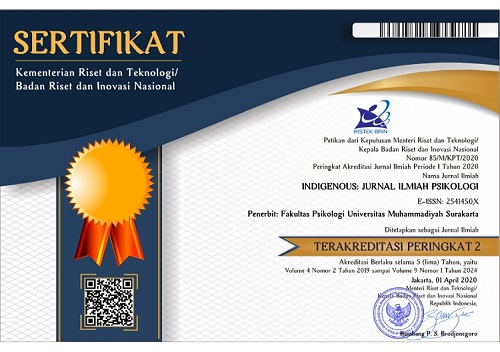The Influence of Benthik Traditional Gameson the Level of Sibling Rivalry among Children: A Quasi-Experimental Study
DOI:
https://doi.org/10.23917/indigenous.v9i1.3010Keywords:
Sibling rivalry, Benthik game, Traditional Indonesian gameAbstract
Abstract.Children's relationships with their siblings encompass a spectrum of experiences, ranging from positive connections to negative interactions. A notable negative facet that can emerge within sibling dynamics is the phenomenon of sibling rivalry. This phenomenon entails the manifestation of competition, jealousy, and animosity among siblings, often arising following the birth of a younger brother or sister.
The prevalence of sibling rivalry is associated with adverse outcomes, including heightened anxiety and impaired emotional regulation in children. To address the intricate issue of sibling rivalry, fostering cooperative interactions among siblings has been proposed as a potential solution. This research aims to describe whether the modification of the traditional game "Benthik" from East Java can reduce sibling
rivalry in children. Additionally, this study also elucidates how the concept of modifying the Benthik game can mitigate sibling rivalry in children. Employing a quasi-experimental methodology, the study was conducted at SD Negeri 1 Sumberjo, Bojonegoro, and involved 30 children aged 8 to 12, each of whom had at least one sibling. The paired sample t-test analysis results reveal a significant influence of
the Benthik game on sibling rivalry conditions in children, with a p-value of 0.035 (<0.05) denoting statistical significance, thereby indicating that the modified Benthik game holds promise as an effective intervention for addressing sibling rivalry. In conclusion, the research contributes not only to the realm of addressing sibling dynamics but also to the preservation and utilization of traditional regional games
amid the pervasive influence of digital engagement.
References
Buist, K. L., Deković, M., & Prinzie, P. (2013). Sibling relationship quality and psychopathology of children and adolescents: A meta-analysis. Clinical Psychology Review, 33(1), 97–106. https://doi.org/10.1016/j.cpr.2012.10.007
Gunawan, H. (2018). Karena dendam, seorang pemuda di Blitar bacok kakak kandung hingga kritis. Tribun News. https://www.tribunnews.com/regional/2018/11/15/karena-dendam-seorang-pemuda-di-blitar-bacok-kakak-kandung-hingga-kritis
Hasinuddin, M. H., & Siti, F. A. (2017). Effect of cooperative play to sibling rivalry direct reaction in children ages 8-12 years in SDN Blega 03 Bangkalan. Proceeding 8th International Nursing Conference "Education, Practice and Development in Nursing. retrieved from https://www.researchgate.net/publication/329982736
Hidayanti, M. (2017). Pengaruh permainan tradisional gatrikan terhadap pengembangan motorik kasar anak kelompok A TK Al-Hidayah Kecamatan Dawuan Kabupaten Majalengka tahun ajar 2017. PUBLICITAS, 11(1), 1–19. https://jurnal.unma.ac.id/index.php/JP/article/view/1263/1167
Juwita, I. (2017). Perbedaan sibling rivalry ditinjau dari pola asuh orang tua pada remaja [Universitas Medan Area]. retrieved from http://repository.uma.ac.id/handle/123456789/8029
Lazdia, W., & Kusuma, V. C. (2019). Pengalaman orang tua dalam menghadapi perilaku sibling rivalry pada anak. Real in Nursing Journal, 2(1), 29–37. https://doi.org/10.32883/rnj.v2i1.488
Lubis, J. E. (2019). Cooperative play untuk menurunkan perilaku sibling rivalry pada anak. Jurnal Harkat : Media Komunikasi Gender, 15(2), 106–115. https://doi.org/10.15408/harkat.v15i2.13467
Maimunah, D. I., Wihardini, E. D. K., Rahmawatik, K. M., & Qoyyimah, N. R. H. (2022). Keefektifan cooperative play dalam menurunkan sibling rivalry pada anak usia sekolah dasar. Flourishing Journal, 2(3), 187–192. http://doi.org/10.17977/um070v2i32022p187-192
Muarifah, A., & Fitriana, Y. F. F. (2019). Sibling rivalry: Bagaimana pola asuh dan kecerdasan emosi menjelaskan fenomena persaingan antar saudara? Journal of Early Childhood Care and Education, 1(2), 48–58. https://doi.org/10.26555/jecce.v1i2.600
Notoatmodjo, S. (2018). Metodologi penelitian kesehatan. Rineka Cipta.
Putri, S. K., & Budiartati, E. (2020). Upaya orang tua dalam mengatasi sibling rivalry pada anak usia dini di KB TK Tunas Mulia Bangsa Semarang. Jurnal Eksistensi Pendidikan Luar Sekolah (E-Plus), 5(1), 75–87. https://jurnal.untirta.ac.id/index.php/E-Plus/article/view/8096/5442
Santrock, J. W. (2014). Psikologi Pendidikan (5th ed.). Salemba Humanika.
Sasmita, R. R. (2020). Hubungan antara attachment dengan sibling rivalry pada siswa sekolah dasar [Universitas Islam Negeri Sultan Syarif Kasim Riau]. retrieved from https://repository.uin-suska.ac.id/28917/
Shaffer, D. R., & Kipp, K. (2014). Development psychology: Childhood and adolescence (9th ed.). Wadsworth Cengage Learning.
Shalehah, A., Hidayatullah, M. S., & Rachmah, D. N. (2018). Penerapan cooperative play dalam bentuk permainan konstruktif untuk meningkatkan keterampilan sosial pada anak usia dini. Jurnal Kognisia, 1(2), 83–94. https://doi.org/10.20527/jk.v1i2.1552
Soekardi, R. (1912). Javaansche Kinderspelen. H.A. Benjamis.
Subaida. (2016). Hubungan cooperative play dengan perkembangan anak usia prasekolah di Taman Kanak-Kanak Negeri Pembina Maesan Kabupaten Bondowoso [Universitas Jember]. retrieved from https://repository.unej.ac.id/bitstream/handle/123456789/73509/112310101048--Subaida-1-86.pdf?sequence=1&isAllowed=y
Tiyaningsih, E. A. (2017). Hubungan tingkat pengetahuan dan perilaku ibu dengan kejadian sibling rivalry pada anak usia 3-6 tahun di Desa Karangduren Kecamatan Sokaraja [Universitas Muhammadiyah Purwokerto]. https://repository.ump.ac.id/4003/
Ulia, A. (2020). Dealing kids rivalry: No drama siblinghood. Penerbit Briliant.
Waluyo, Y., & Purwandari, E. (2010). Fenomena anak kembar: Telaah sibling rivalry. Indigenous: Jurnal Ilmiah Psikolog, 12(2), 154–160. https://doi.org/10.23917/indigenous.v0i0.4754
Watson, R. (2015). Quantitative research. Nursing Standard, 29(31), 44–48. https://doi.org/10.7748/ns.29.31.44.e8681
World Health Organization (WHO). (2014). WHO calls for stronger focus on adolescent health. WHO Media Centre. https://www.who.int/news/item/14-05-2014-who-calls-for-stronger-focus-on-adolescent-health
Downloads
Submitted
Published
How to Cite
Issue
Section
License
Copyright (c) 2024 Adinda Putri Sholikhah, Abadina Ukhtisiwi, Lia Kurniawati, Anisya Salsabila Ainun Nur Azizah

This work is licensed under a Creative Commons Attribution 4.0 International License.











